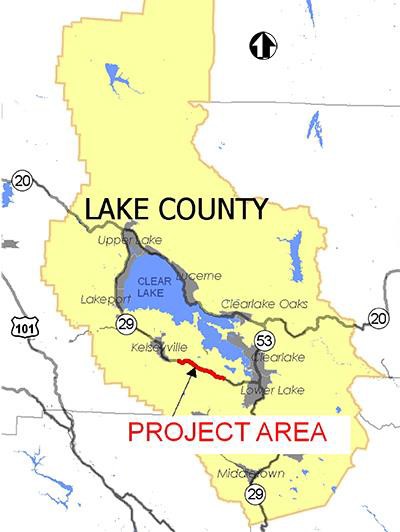Highway 29 Expressway Improvement Project
 The Project
The ProjectThis project will widen an 8-mile section of Route 29 (constructed in 3 phases: segments 2A, 2B, and 2C) from two lanes to a four-lane divided highway with access control. The project is located between the communities of Lower Lake and Kelseyville in Lake County.
Problem
The project portion of SR 29 was originally a county road that was brought into the State Highway System (SHS) in 1951. Limited geometric improvements have been made since the transition into the SHS, which has left a facility with an inconsistently applied design speed and existing geometrics not consistent with its use today and into the future. The current 2-lane highway has at-grade intersections, narrow shoulders, limited passing opportunities, congestion and unstable traffic flow. It is not safely nor effectively managing the current traffic flows, nor will it for anticipated traffic growth into the future.
MULTIMODAL
Currently, interregional and truck traffic is concentrated on State Route 20 (SR 20) within the north shore communities around Clear Lake. These north shore communities are considered “Main Street” communities in the towns of Nice, Lucerne, Glenhaven, and Clearlake Oaks. Pedestrian/bicycle safety, traffic noise and quality of life have been ongoing concerns and issues in these communities in large part due to the interregional and truck traffic utilizing SR 20 that passes through them. This 23-mile long segment of SR 20 was designated a Pedestrian Safety Corridor in 2007 because of a collaborative effort between Caltrans, the California Highway Patrol (CHP) and local businesses/residents. The Regional Transportation Plan calls for redirecting interregional traffic onto the SR 20/29/53 Principal Arterial Route, which would minimize the interregional traffic through the “Main Street” communities. The Lake Area Planning Council has prepared multiple plans for traffic calming and active transportation improvements along the north shore.1 By constructing the Lake 29 Expressway, truck speeds and travel time reliability will increase by providing consistent and increased free-flow speeds. As a result, interregional traffic will be encouraged to utilize the south shore corridors, while the north shore communities experience an increase in multimodal corridor safety.
EQUITY
At $42,475, Lake County has the second lowest median household income of all California counties. According to the California Healthy Places Index, Lake County has healthier economic conditions than just 1.8% of other California counties and 50% of people have an income significantly below the federal poverty level. Lake County also has a relatively high number of people over the age of 60, 30% compared to 19% statewide. Lake County economic development has been impeded by the difficulty of transporting goods into and out of the county. The north shore communities along SR 20 are prime locations for revitalization of the tourism and hospitality industry that thrived early in Lake County’s history. Current traffic conditions on the north shore are impeding this revitalization. Along the north shore, residences, schools, parks and shopping destinations are located adjacent to the highway and the interregional and truck traffic moving through these communities has negatively impacted the quality of life for residents and visitors with air pollution, noise and traffic safety. SR 29 is better suited to manage interregional traffic as it does not serve as a main street for any communities and adjacent land uses are mostly agricultural and industrial.
CLIMATE CHANGE
The benefits of a completed project are also in line with the Caltrans 2015 Interregional Transportation Strategic Plan (ITSP), which identifies the SR 20/29/53 Principal Arterial Corridor as a “Strategic Interregional Corridor”. According to the ITSP, the interregional facility “provides the corridor with vital connections to the interstate system and the rest of the State, providing access to basic goods and services along with routine and emergency medical services. Nearly all segments of the SHS are identified as high wildfire exposure by 2055 in the 2019 Caltrans Climate Change Vulnerability Assessment. This corridor would be the major transportation corridor for response and recovery efforts in the event of emergencies such as forest fires. The region and Lake County have experienced increased and high levels of wildland fire damage with significant wildfires in Lake County in 2015, 2016, 2017 and 2018 burning over 600,000 acres. This project will help move people efficiently out of evacuation areas and provide efficient mobility for emergency response.
SAFETY
The proposed project is expected to significantly improve overall safety for all modes of transportation. Current collision data shows that within the project limits, approximately half of all collisions result in injury. For users of SR 29 a modern four-lane facility that meets current design standards will accomplish the following: improvements to the horizontal and vertical alignment, addition of lanes that would create safer passing opportunities, removal of fixed objects, widening of shoulders, and the addition of a 36-foot un-paved median that would provide safety benefits to motorists in terms of increased sight distance, enhanced recovery areas, separation of traffic, and minimized exposure to fixed objects. The proposed project is expected to improve overall safety for bicyclists by providing widened shoulders that bicyclists can use, thus reducing modal conflicts. In addition to the direct benefit of SR 29 users, there will be significant benefit to non-motorized users of SR 20 within the “Main Street” communities listed prior by encouraging interregional and truck traffic to utilize the Principal Arterial Corridor of SR 20/29/53.
Status
The final environmental document was completed in November of 2016 for all three segments. Segment 2C was successful in obtaining construction and right of way funding and is currently in construction. Segments 2B and 2A were funded through design by the 2018 STIP and are currently in the design phase. Caltrans and Lake APC are seeking funds for both construction and right of way for the two unfunded segments.
